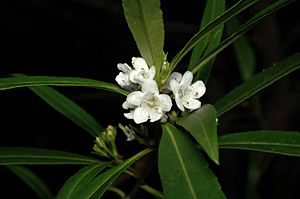Mountain boobialla facts for kids
Quick facts for kids Mountain boobialla |
|
|---|---|
 |
|
| Scientific classification | |
| Genus: |
Myoporum
|
| Species: |
betcheanum
|
The mountain boobialla (scientific name: Myoporum betcheanum) is a cool plant that belongs to the figwort family. It's usually a bush or a small tree. This plant has long, thin leaves that are darker green on top and lighter underneath. Its pretty white flowers grow in small groups where the leaves meet the stem. After the flowers, you'll see soft, round, cream-colored fruits called drupes (which are like small stone fruits). As its name suggests, the mountain boobialla likes high places, usually around 1,000 meters (about 3,300 feet) above sea level. You can find it in the McPherson Range and other mountains nearby in New South Wales and Queensland, Australia.
Contents
What Mountain Boobialla Looks Like
The mountain boobialla is a bush or a small tree that can grow up to about 8 meters (26 feet) tall. Its branches often have small, wart-like bumps called tubercles. They are also covered with soft hairs.
The leaves are long and narrow, usually about 58 to 130 millimeters (2.3 to 5.1 inches) long and 6 to 19 millimeters (0.24 to 0.75 inches) wide. They are flat and shaped like a narrow oval, with tiny teeth along their edges. The top side of the leaves is darker green, and both sides have short, soft hairs.
Flowers and Fruits
The flowers grow in groups of 3 to 8 on short stalks where the leaves join the stem. Each flower has 5 sepals (small leaf-like parts that protect the bud) and 5 white petals. The petals are joined at their base to form a tube, which is about 2.9 to 4.9 millimeters (0.11 to 0.19 inches) long. The tips of the petals are about 2.8 to 3.7 millimeters (0.11 to 0.15 inches) long. Each flower also has 4 stamens, which are the parts that produce pollen.
Mountain boobialla flowers bloom between December and May. After the flowers, the plant grows fruits. These fruits are called drupes and have three sections, with one seed in each section. They are generally round or oval-shaped, smooth, and are white or cream-colored, sometimes with a touch of pink.
How Mountain Boobialla Got Its Name
The scientific name Myoporum betcheanum was first officially described in 1969 by a scientist named Lindsay Stuart Smith. He wrote about it in a publication called Contributions from the Queensland Herbarium. The second part of the name, betcheanum, was chosen to honor Ernst Betche. He was the first person to realize that this plant was a unique species, different from others.
Where Mountain Boobialla Grows
You can find the mountain boobialla growing on the edges of rainforests and in wet forests. It prefers high places, usually between 850 and 1,100 meters (2,790 to 3,610 feet) above sea level. It grows in the mountains of the Great Dividing Range north of Casino in New South Wales. It also lives in the McPherson Range and other nearby mountains in Queensland.
Growing Mountain Boobialla in Gardens
The mountain boobialla is a great plant for gardens. Even though its flowers are small, there are lots of them, and they bloom for a long time. This makes the plant look very attractive. It's also easy to grow new plants from cuttings (small pieces of the plant that can grow roots).

